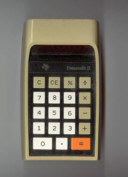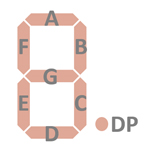
DATAMATH CALCULATOR MUSEUM
 |
DATAMATH CALCULATOR MUSEUM |
Characterization of NEC Single-chip Calculator Circuits - µPD940 Series
The DCM-50A Platform supports the Characterization of many Non-TI single-chip calculator circuits with up to 42-pin packages using the DCM-50A Playground DIL42 Adapter mounted on top of the DCM-50A PG Frame Carrier with the voltages VSS and VDD/VGG set to the appropriate levels.
| • Package Markings Top:
µPD940C H5728M • Package Markings Bottom: • Donor Calculator: Lloyd's Accumatic 30 (Model EH-9036, Type 255G), September 1975 |
Keyboard: The Lloyd's Accumatic 30 makes use of a keyboard assembly with 19 spring-supported plastic keys pushing small fingers on stamped sheet-metal pieces against contacts etched on a single-sided phenolic PCB. All switches are arranged in a 6*4 matrix with the rows connected to the SA-SF Outputs (Segment Scan) and the columns connected to the K0 to K3 Inputs (Keyboard Scan) of the µPD940 single-chip calculator circuit.
Keyboard Matrix of the Lloyd's Accumatic 30 (Model EH-9036, Type 255G):
µPD940 | ||||
| K0 | K1 | K2 | K3 | |
| SA | CE | C | ||
| SB | = | % | ||
| SC | + | − | × | ÷ |
| SD | 7 | 8 | 9 | |
| SE | 3 | 4 | 5 | 6 |
| SF | . | 0 | 1 | 2 |
![]() Display: The
Lloyd's Accumatic 30 makes use of an 9-digit Futaba 9-CT-08
low-voltage Vacuum Fluorescent Display (VFD) connected directly to the
respective 9 Digit Outputs D1 to D9 and 8 Segment Outputs SA to SG and SDP of
the µPD940 and biased to approximately -28 Volts.
Display: The
Lloyd's Accumatic 30 makes use of an 9-digit Futaba 9-CT-08
low-voltage Vacuum Fluorescent Display (VFD) connected directly to the
respective 9 Digit Outputs D1 to D9 and 8 Segment Outputs SA to SG and SDP of
the µPD940 and biased to approximately -28 Volts.
Display Layout:
| Futaba 9-CT-08 |
|
|
| The Segment drivers A-G and DP (Decimal Point) are connected to the Futaba 9-CT-08 display in the pictured way. |  |
Display Fonts:
| Type | Calculator | Number Fonts | Decimal Separator |
Thousands Separator |
Entry Overflow |
Calculating Overflow |
Minus |
| µPD940 | Lloyd's Accumatic 30 |
n.a. |
Keyboard Scanning: The µPD940
Series of single-chip calculator circuits utilizes six of its eight
segment outputs to scan the keyboard after each display scanning cycle. Only the
necessary digit-driver outputs are activated, when displaying a "0." only D1
would be enabled. The D10 to D12 Digit Times are used for keyboard scanning with
the segment-driver outputs, while the display is blanked. The provided recording
shows the moment the [=] key located in the keyboard scan matrix of segment
output SB and keyboard input K0 was registered while displaying '1.'.
Display
scanning: Display scanning is performed in D1 → D9 direction at a rate of
about 1,040 Hz:
|
• State Time = 1 Clock =
0.020 ms @ CK=50 kHz • Digit Time = 4 States = 0.080 ms @ CK=50 kHz • Scan Time = 12 Digit Times (D1 to D9 with D10 to D12 a dead cycle) = 0.960 ms @ CK=50 kHz |
| • Package Markings Top:
µPD941C H5X486 • Package Markings Bottom: • Donor Calculator: MBO de Luxe I, December 1975 |
Keyboard: The MBO de Luxe I makes use of a keyboard assembly with 20 snap action switches and a sliding power switch soldered on a single-sided phenolic PCB. All switches are arranged in a 6*4 matrix with the rows connected to the SA-SF Outputs (Segment Scan) and the columns connected to the K0 to K3 Inputs (Keyboard Scan) of the µPD941 single-chip calculator circuit.
Keyboard Matrix of the MBO de Luxe I:
µPD941 | ||||
| K0 | K1 | K2 | K3 | |
| SA | CE | C | ||
| SB | = | % | +/− | |
| SC | + | − | × | ÷ |
| SD | 7 | 8 | 9 | |
| SE | 3 | 4 | 5 | 6 |
| SF | . | 0 | 1 | 2 |
![]() Display:
The MBO de Luxe I makes use of an 9-digit Itron DP95A4
low-voltage Vacuum Fluorescent Display (VFD) connected directly to the
respective 9 Digit Outputs D1 to D9 and 8 Segment Outputs SA to SG and SDP of
the µPD941 and biased to approximately -28 Volts.
Display:
The MBO de Luxe I makes use of an 9-digit Itron DP95A4
low-voltage Vacuum Fluorescent Display (VFD) connected directly to the
respective 9 Digit Outputs D1 to D9 and 8 Segment Outputs SA to SG and SDP of
the µPD941 and biased to approximately -28 Volts.
Display Layout:
| Itron DP95A4 |
|
|
| The Segment drivers A-G and DP (Decimal Point) are connected to the Itron DP95A4 display in the pictured way. |  |
Display Fonts:
| Type | Calculator | Number Fonts | Decimal Separator |
Thousands Separator |
Entry Overflow |
Calculating Overflow |
Minus |
| µPD941 | MBO de Luxe I |
n.a. |
Keyboard Scanning: The µPD940
Series of single-chip calculator circuits utilizes six of its eight
segment outputs to scan the keyboard after each display scanning cycle. Only the
necessary digit-driver outputs are activated, when displaying a "0." only D1
would be enabled. The D10 to D12 Digit Times are used for keyboard scanning with
the segment-driver outputs, while the display is blanked. The provided recording
shows the moment the [=] key located in the keyboard scan matrix of segment
output SB and keyboard input K0 was registered while displaying '1.'.
Display
scanning: Display scanning is performed in D1 → D9 direction at a rate of
about 1,040 Hz:
|
• State Time = 1 Clock =
0.020 ms @ CK=50 kHz • Digit Time = 4 States = 0.080 ms @ CK=50 kHz • Scan Time = 12 Digit Times (D1 to D9 with D10 to D12 a dead cycle) = 0.960 ms @ CK=50 kHz |
| • Package Markings Top:
µPD943C R5X096 • Package Markings Bottom: • Donor Calculator: Royal 90K (Model UA120), November 1975 |
Keyboard: The Royal 90K (Model UA120) makes use of a keyboard assembly with a sliding power switch and 19 spring-supported plastic keys pushing small fingers on stamped sheet-metal pieces against contacts etched on a single-sided phenolic PCB. All switches are arranged in a 5*4 matrix with the rows connected to the SB-SF Outputs (Segment Scan) and the columns connected to the K0 to K3 Inputs (Keyboard Scan) of the µPD943 single-chip calculator circuit.
Keyboard Matrix of the Royal 90K (Model UA120):
µPD941 | ||||
| K0 | K1 | K2 | K3 | |
| SA | ||||
| SB | = | % | CI | C |
| SC | + | − | × | ÷ |
| SD | 7 | 8 | 9 | |
| SE | 3 | 4 | 5 | 6 |
| SF | . | 0 | 1 | 2 |
![]() Display:
The Royal 90K (Model UA120) makes use of an 9-digit Futaba 9-ST-10
low-voltage Vacuum Fluorescent Display (VFD) connected directly to the
respective 9 Digit Outputs D1 to D9 and 8 Segment Outputs SA to SG and SDP of
the µPD943 and biased to approximately -28 Volts.
Display:
The Royal 90K (Model UA120) makes use of an 9-digit Futaba 9-ST-10
low-voltage Vacuum Fluorescent Display (VFD) connected directly to the
respective 9 Digit Outputs D1 to D9 and 8 Segment Outputs SA to SG and SDP of
the µPD943 and biased to approximately -28 Volts.
Display Layout:
| Futaba 9-ST-10 |
|
|
| The Segment drivers A-G and DP (Decimal Point) are connected to the Futaba 9-ST-10 display in the pictured way. |  |
Display Fonts:
| Type | Calculator | Number Fonts | Decimal Separator |
Thousands Separator |
Entry Overflow |
Calculating Overflow |
Minus |
| µPD943 | Royal 90K (UA120) |
n.a. |
Keyboard Scanning: The µPD940
Series of single-chip calculator circuits utilizes six of its eight
segment outputs to scan the keyboard after each display scanning cycle. Only the
necessary digit-driver outputs are activated, when displaying a "0." only D1
would be enabled. The D10 to D12 Digit Times are used for keyboard scanning with
the segment-driver outputs, while the display is blanked. The provided recording
shows the moment the [=] key located in the keyboard scan matrix of segment
output SB and keyboard input K0 was registered while displaying '1.'.
Display
scanning: Display scanning is performed in D1 → D9 direction at a rate of
about 1,040 Hz:
|
• State Time = 1 Clock =
0.020 ms @ CK=50 kHz • Digit Time = 4 States = 0.080 ms @ CK=50 kHz • Scan Time = 12 Digit Times (D1 to D9 with D10 to D12 a dead cycle) = 0.960 ms @ CK=50 kHz |
If you have additions to the above article please email: joerg@datamath.org.
© Joerg Woerner, November 9, 2024. No reprints without written permission.